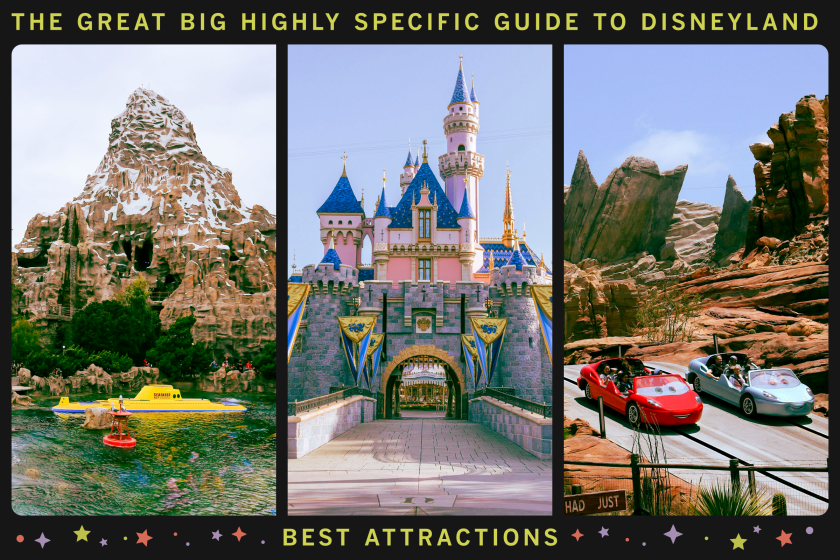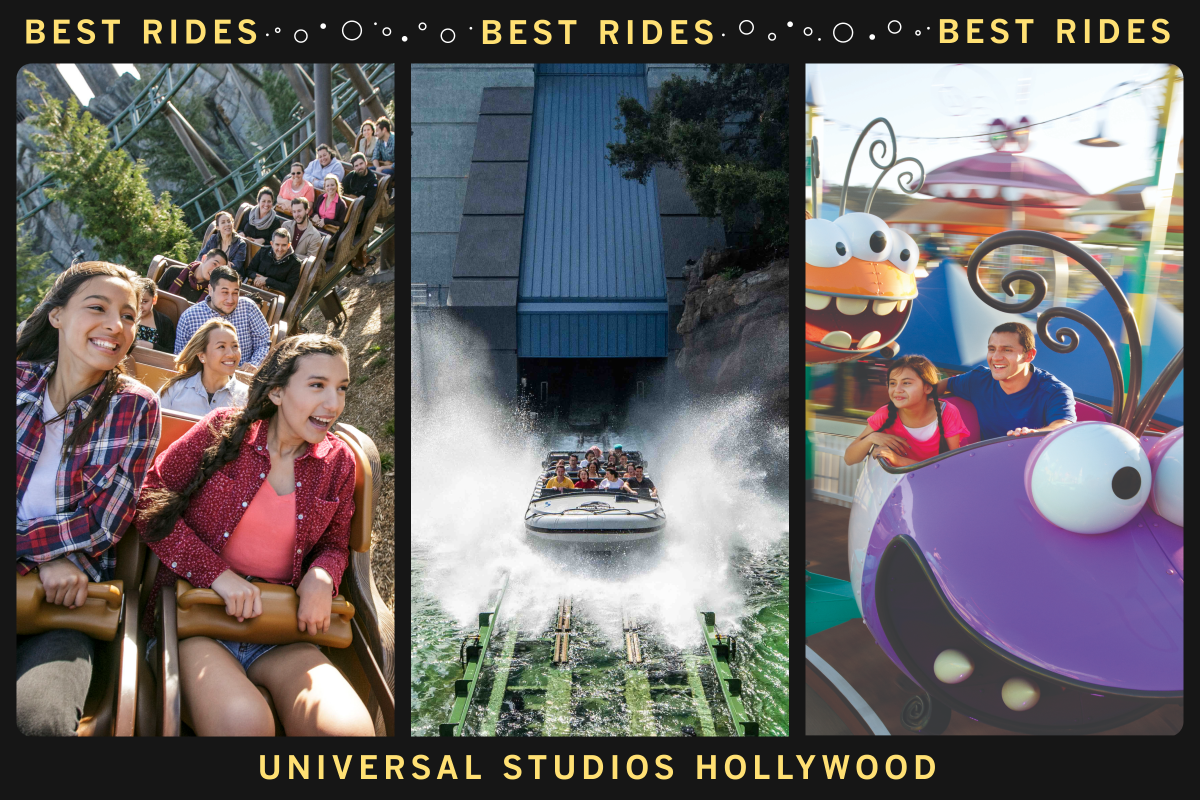
Every ride at Universal Studios Hollywood, ranked
- Share via
The strength of Universal Studios is its constraints. This is a theme park set in a working movie studio. While that means space is at a premium, it creates a lively, “only in SoCal” energy that no other theme park can match.
Ranking the rides and attractions at Disneyland and California Adventure from best to worst is hard — but not impossible. Here is the ultimate Disneyland ride ranking.
That also means designers must get creative in using the available land, requiring the park, sometimes to its detriment, to rely too heavily on screen-based attractions. Yet no other theme park can boast something as unique as the World Famous Studio Tour, a beast of an attraction that not only takes guests through potentially working sets but gives us light thrills and glimpses of Hollywood history like the “Psycho” house. The tram-based trek, celebrating its 60th anniversary in 2024, has a long history with the studio and heavily influenced the TV- and movie-focused approach of modern theme parks.
Universal Studios Hollywood is also a park in transition. Though not nearly as large as its Florida counterpart, the West Coast original has added in recent years multiple all-enveloping areas, including the Wizarding World of Harry Potter and Super Nintendo World. Coming in 2026 is the park’s first grown-up roller coaster, a thrill ride set in the “Fast and Furious” universe that is literally being built on a hill.
Planning your weekend?
Stay up to date on the best things to do, see and eat in L.A.
Universal Studios Hollywood aims to reflect our modern entertainment industry, from movies to, more recently, games. But how a theme park interprets pop culture is an art unto itself, so consider this guide not simply a ranking of Universal’s attractions and experiences but a look at how a theme park can illuminate cultural myths and stories.
1. The World Famous Studio Tour

The Universal Studios tram tour — officially designated as the World Famous Studio Tour — is today a polished theme park ride, a large-scale attraction bundled with a host of mini attractions within it. From a shark attack referencing Steven Spielberg’s “Jaws” to a jaunt through the fake rural amusement park of Jordan Peele’s “Nope,” the tour serves as a crash course in the last 50 years of Universal blockbusters, all while jostling park guests through a simulated earthquake and a 3-D encounter with King Kong.
It’s also rooted in Universal’s beginnings. Universal Pictures founder Carl Laemmle welcomed fans in 1915 to watch how silent films were made, charging them a quarter and giving them a box lunch in the deal. Yet different eras bring different financial motivations. The modern Studio Tour is rooted in a more basic human desire: We need to eat.
In the early 1960s, according to Stephen M. Silverman’s book “The Amusement Park,” Universal began welcoming Gray Line Tours onto the studio lot for Hollywood history jaunts. The primary goal was to boost the bottom line of the studio commissary, where Gray Line guests would stop for lunch. It was a success, and mogul Lew Wasserman allowed his staff to investigate the feasibility of the studio running its own tour.
Universal’s tour had its grand opening on July 15, 1964, but it would be about a decade before it started to become what we recognize today. Jay Stein, who had worked his way up the Universal ranks after starting in the mailroom, would begin a makeover of the tram tour, one that shifted it from its behind-the-scenes, borderline educational focus to one that instead was centered around light thrills and mechanical, movie magic tricks. Movie studios, he reasoned, simply weren’t all that exciting.
By the mid-1970s, the Studio Tour would begin to reshape the modern theme park industry, not only ushering Universal into the field but recentering the entire medium as one that would be based around film and television franchises — intellectual property, or “IP,” in industry-speak.
Everything changed in 1976. That was one year after Spielberg’s “Jaws” opened and when the Studio Tour built a mini re-creation of an Eastern seaboard waterfront and put guests face-to-face with a 24-foot shark. Nothing on the level of the cultural phenomenon that was “Jaws” had so quickly been replicated in a theme park before.
The modern theme park would become a place to “ride the movies,” as Spielberg, who has long had a close relationship with Universal and its theme parks, branded it. It’s an industrywide trend that hasn’t stopped.
2. Mario Kart: Bowser’s Challenge
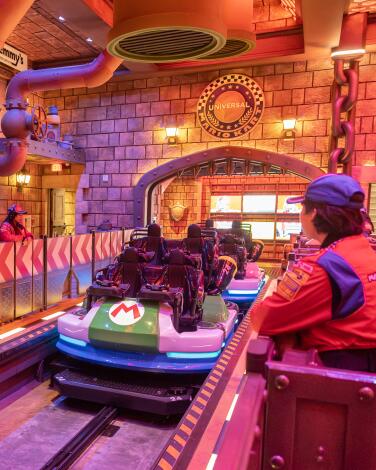
The ride, which opened in 2023, stands as the first major implementation of augmented reality in a North American theme park attraction. While we move at a relatively modest pace along a track, our tech-enabled visors provide a digital makeover of the rather elaborate, blacklight-enhanced theatrical sets, which lead us above and underwater, into a haunted passageway and onto “Mario Kart’s” famed multicolor Rainbow Road. As we traverse the track we’ll acquire shells, which we can press a button to throw at our opponents, our digital pal Mario, the environments or other karts, all while real-time animation responds to our actions.
It’s a bit chaotic when one rides for the first time and is still getting acquainted with the attraction’s layout and its controls, but it can start to feel natural on the second ride-through. That’s because we aim by looking, simply focusing on what and where we want to toss a shell. And augmented reality combined with built sets allows the game to come to our world rather than placing us in an attraction that moves us among screens. Smartly, the emphasis is on riding alongside Mario and his pals more than it is winning or losing, creating a sense of camaraderie.
Most important, it’s a ride that embodies the game-design philosophies of Mario creator and master game designer Shigeru Miyamoto.
“When we’re building games, a lot of people may think it’s something digital,” Miyamoto told me last year. “All you really need is your screen and your fingers, and that encompasses all of what games have to offer. But I feel there’s more to it. It’s when that virtual experience that you’re having in the game is able to make a connection to real-life experiences that you had. That’s what results in people really enjoying the game and being touched and moved by the game.”
3. The Secret Life of Pets: Off the Leash

The emphasis is largely on the joy of the emotional design of physical, built environments — a New York cityscape that comes alive with dogs doing yoga, dogs taking a spa day in a hot dog cart, cats swinging from roped blankets and one ill-advised scheme to use fireworks as aircraft.
The ride contains 64 robotic animal figurines and thus relies on old-school theme park philosophies. The focus is on animation-worthy vignettes rather than a strict beginning, middle and end to the ride. There’s an underlying narrative — you’re a pup up for adoption — but in just a few minutes the ride switches through multiple locales, from posh New York apartments to a cat-bullied alleyway to a pet wash and more. Guests are constantly looking around them, and often above them, to pick up on the screwball hijinks.
While based on the film and featuring its characters, prior knowledge isn’t needed. This isn’t a “ride the movie” sort of experience so much as one that wants to give us weird, colorful scenarios to imagine our own storylines.
4. Jurassic World: The Ride
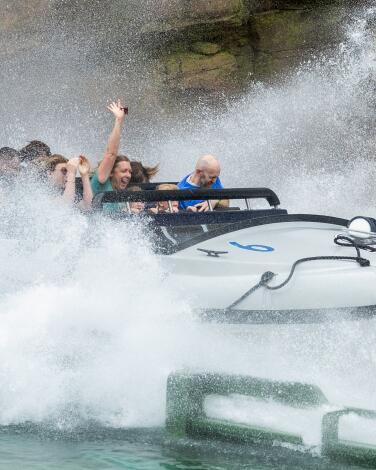
The ride was revamped in 2019, now themed to the “Jurassic World” movies and starring Chris Pratt, Bryce Dallas Howard and B.D. Wong. Gone is some of its sense of pacing, but in its place is more thrills. Jurassic World keeps things simple; this is a theme park ride gone wrong from beginning to end. Rather than start with the former’s calming, mesmerizing scene in which the elongated neck of the veggiesaurus towered over our boats, we now glide into an aquarium with a shark-eating mosasaurus looking hungrily at us tourists. Forget any moments to take in John Williams’ rousing score; we may as well be dangling on a fishing rod from the ride’s opening seconds.
Special effects, thrills and getting guests drenched are top priorities, although the ride still has a sense of humor (be on the lookout for some baby dinos playfully wreaking havoc). With the threat of getting soaked from its opening moments, the ride doesn’t really build in tension, but it does lead to a showstopping dinosaur battle between an ultrasaurus and a T. Rex. The climactic clash is a thing of wonder, with large-scale animatronics tussling above us. We want to linger and marvel at the drama unfolding, but just when we experience a sense of grandeur, it’s time to jaunt over the hill and speed down Jurassic World’s massive drop.
The ride has changed over the years, but its underlying mission — to put us in the presence of extinct creatures and have us gape at them — hasn’t. “Dinosaurs were bigger than anything we can relate to,” Steven Spielberg, who consulted on the attraction, told The Times before the ride’s initial opening in 1996. “That’s why they fill us up with a sense of awe.”
5. Harry Potter and the Forbidden Journey

A dragon, captured in CGI cinematics in one juncture, appears in the flesh — well, if theme park creations had flesh — and lurches toward riders in the next. Though the ride features appearances from the cast of the films, what lingers are the physical elements rather than the virtual ones.
Little details, such as the broken wood as riders wonder where the dragon went, seem to better create a sense of presence when they feel like they can almost be touched. Likewise the temperamental Whomping Willow tree. As guests spin and the tree lurches, all sense of direction is obscured, a deception that isn’t broken by a blur of the screen.
Forbidden Journey opened in Orlando in 2010 — it landed in Hollywood in 2016 — and the goal was always to merge the real world with the virtual one. One of the most striking moments of the ride is when Hermione (Emma Watson) appears on a screen to wave a wand and send guests flying into the air. It creates an illusion of interactivity, breaking down some of the static barriers that typically come with screen-based rides. The attraction, ultimately, is more of a “greatest hits” collection of “Harry Potter” films than one that follows an original storyline or theme, but that likely won’t matter to fans who want to see the world sprung to life.
6. Waterworld

The plot is clearly defined: The good folks seek dry land, and the bad ones are trying to keep them from it. And we buy into it, thanks to the rusty-colored, fragile-looking dystopian structures that dot the landscape. Everything is made to look a little ramshackle, including the jet skis and boats that criss-cross one another in close quarters. Heroics are punctuated with fireworks, pyrotechnic effects accompany the toppling of a 20-foot water tower and stunt actors catapult from nearly any structure that will hold them. There’s even a full-scale seaplane that crashes the scene, but no spoilers as to when or how.
When all is said and done, there are around 55 pyrotechnic detonations and our heroine survives a number of close calls with the enemy. But more important, Waterworld leans into Universal’s movie magic history. After all, what would a theme park at a working studio be without a show dedicated to stunts and special effects?
7. The games of Super Nintendo World
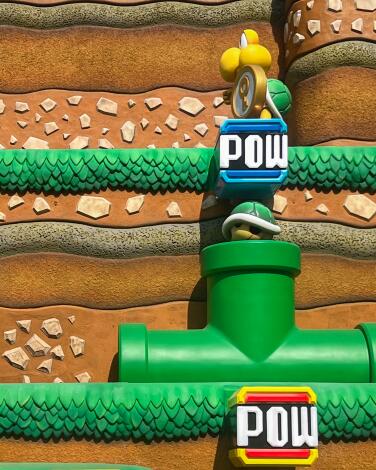
Beyond the Mario Kart: Bowser’s Challenge ride, there are a series of mini-games that dot the space, appearing naturally — embedded into the design of the land rather than staged in a more carnival-focused setup. The idea is we have entered a game world rather than a place to play games.
One has us turning a crank to fell a Goomba, one of those wobbly, mushroom-like creatures. Another has us punching a block to unleash a shell in the hopes of hitting a Koopa, a turtle-inspired adversary. Some require participating with a larger group or strangers, such as one in which we are trying to turn off vintage-designed toy clocks. There is a final collective battle that involves full body participation, but a word of warning: One will need to purchase a $40 Power-Up Band to gain access to this climatic battle (although you may be able to charm your way in).
The games turn Super Nintendo World into a land of curiosity, a place to wonder about the possibilities of interactivity and free us up to be silly.
8. Ollivanders and the interactive wands of Wizarding World

There’s a mini show, tucked into Ollivanders wand store, in which tricks of the light and clever changes in the surroundings — shelves that collapse and then reassemble, drawers that wildly fly open — are designed to showcase the illusion of magic. It’s lightly mystical, and the space, outfitted like a cluttered library dedicated to wands, transports us to an old-world nook where sorcery feels plausible. Just note that if you — or someone in your party, especially if that someone is a little one — gets chosen to participate, you may suddenly find yourself talked into buying a wand.
But beyond being a dust-collecting souvenir, the wand will turn Hogwarts into a living space, as there are 11 windows throughout the land where one can find places to play. Static candy boxes can come alive, a feather pen can take flight and musical notes can soar around an instrument. Each one is a mini delight, and turns our surroundings in an active set.
9. Flight of the Hippogriff

The coaster does its best with minimal space, taking riders up a short lift and then largely getting its thrills via heavily angled turns. It’s worth riding, in part, for the views of the stony Hogwarts Castle, a majestic structure that only feels more powerful when we’re able to get a little height for a full view of the building. It’s alternately medieval and approachable.
Then it’s over. But did we mention it features a mechanical hippogriff bowing its head toward us? And blissfully, unlike many of the attractions remaining on this list, it doesn’t use screens.
10. Transformers: The Ride 3-D
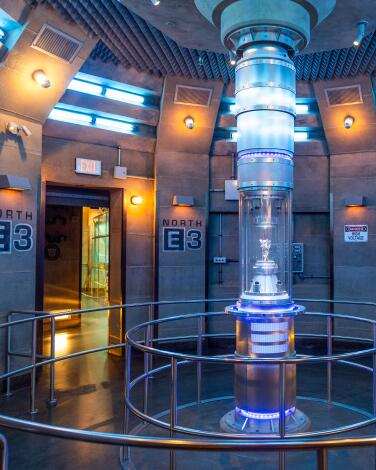
The good: It’s a tech marvel, merging large-scale screens with some light physical sets. Cinematic moments give way to more tangible ones. The attraction impressively moves us around a tight space, as at times we’re in an elevator going up surrounded by 60-foot movie screens. There’s constant motion, and the robotic creatures treat our ride vehicle as a volleyball. There’s a neat trick where Megatron appears to leap out of the screen and attack our ride vehicle. It also features a snippet of James Brown’s “I Feel Good.”
The bad: This ride is pure commotion. We’re essentially watching a movie but being whiplashed back and forth and side to side while doing so. Get used to the sound of screeching tires. Where we are from moment to moment becomes difficult to follow. At one point, a robot, Devastator, nearly eats us, but somehow we escape the blades. And depending on one’s tolerance for screen-based attractions, this fictional city may as well be called Motion Sickness, U.S.A. And speaking of screens, no matter how big or crisp they are, they’ll eventually date an attraction.
When it comes to merging a motion simulator with a thrill ride, Transformers is one of the better examples of the form, but it’s an acquired taste.
11. DreamWorks Theatre Featuring Kung Fu Panda
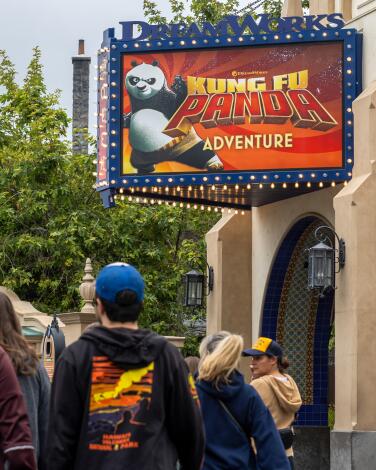
Before entering the theater guests are treated to a preshow that features nods to numerous DreamWorks animated films, intermixing franchises such as “Kung Fu Panda” with “Shrek” and “Trolls.” Screens are above us and surrounding us, creating a lively atmosphere. There’s also a display case full of illuminated weapons. Keep an eye on these for a simple illusion.
The actual show brings us into the world of “Kung Fu Panda,” with our hero, Po, encountering some wolf pirates in a tropical forest. Chases and battles ensue over mystical objects, and the story is supplemented with some standard theme park tricks — bursts of air and water — as well as projection effects that eventually envelop the whole theater, expanding the film beyond the screen.
It’s well done, and it makes the argument that screen-based attractions work best when a more passive approach is taken.
12. Revenge of the Mummy: The Ride
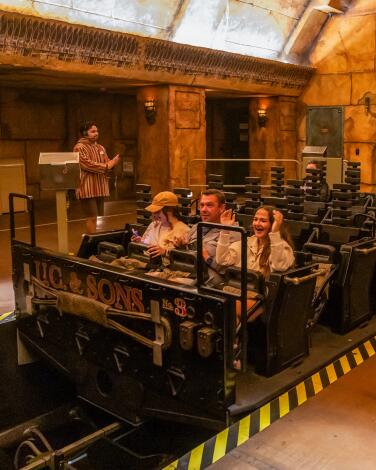
And that’s when the inside roller coaster takes off.
Illuminated mummy warriors flash around us as we speed around corners and launch backward and forward. The effects are borderline carnival-worthy, but no matter, it’s all B-movie fun, although it does contrast greatly with the built sets from the ride’s intro scenes. But then it just ... wraps. That’s all fine and dandy — theme park fans are used to brief roller coasters — but as far as I can tell, our souls are still trapped in this tomb. While we are, of course, let off the attraction, narratively there is no escape. Our souls are forever gone. The end.
13. Silly Swirly
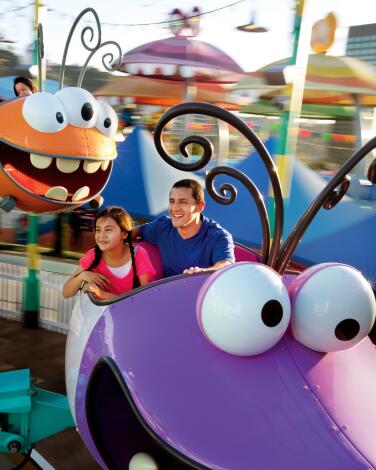
Set in a kid-focused land themed to the Minion-inspired carnival from the “Despicable Me” franchise, Silly Swirly does as advertised: It lifts guests up into the air, and then spins them around at a moderate pace. It adds a bit of energy to the area, and also serves as a nice palate cleanser from the Despicable Me Minion Mayhem attraction next door. The critter vehicles — all elongated teeth and eyes inspired by googly stickers — add a bit of color and goofiness to the area. Added bonus: no screens.
14. Despicable Me Minion Mayhem
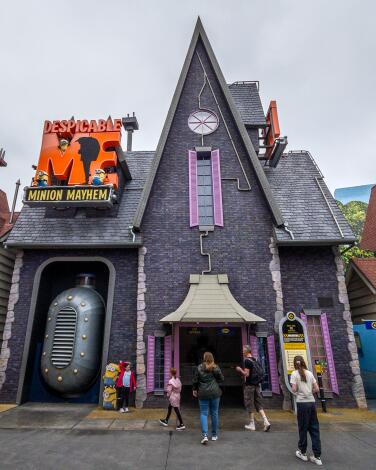
From there we enter the auditorium. Rows are broken up into mini ride vehicles, which will mildly rock visitors back and forth and side to side throughout the experience. The plan to turn us all into minions goes haywire, of course, as our training to become a minion soon becomes little more than pandemonium. The film is cute enough, as we bounce and soar through a childlike obstacle course, beginning with a trampoline onto a cactus and careening us around mattresses, buzzsaws, conveyor belts and even a mini roller coaster. Those easily motion sick beware, as simulators that put riders on a track when there is clearly no visible actual track can be perilous to the stomach (looking in your direction, The Simpsons: The Ride).
15. The Simpsons: The Ride
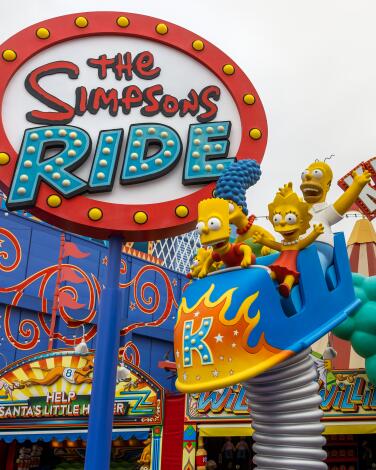
The result is that we are not immersed in the world of “The Simpsons.” Rather we are forced to endure a motion-sickness generator that lacks pacing — at no point does the ride feature a breather from either the hectic animation or its attempts to jerk us in one direction or another. In turn, any of the charm or humor of “The Simpsons” is absent. This frenetic, tensionless disaster is set in the fake theme park of Krustyland, and the ride attempts and fails to crack jokes at the likes of Disneyland, which only serves to allude to better rides we’d rather be on.
Good luck, too, if you’re in the back row of the ride vehicle, as a significant amount of the action takes place on the lower portion of the screen. There’s also no rush of cold air being thrust upon riders, and the absence of ventilation will only make this attraction worse for those prone to motion sickness.
Think of it like watching a widescreen animated version of someone filming a roller coaster. It simply doesn’t work; our brain isn’t fooled by the fake surroundings and the motion utterly fails to align with what’s on the screen. When the images call for rickety, the ride instead opts for whiplash. The screen tells us we’re falling, and our vehicle instead pushes forward. It should come with barf bags.
Ride it only to marvel at the fact that something this haphazard actually exists.


